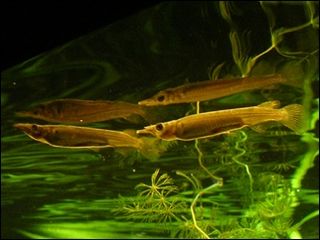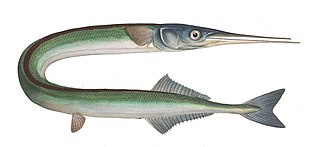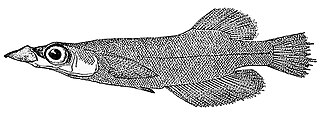
The wrestling halfbeak also known as Malayan halfbeak is a species of viviparous halfbeak native to the fresh and brackish waters of rivers and coastal regions in South-East Asia, in Singapore, Thailand, Indonesia, Thailand, Malaysia, Borneo and Sumatra. It is a small, slender, livebearing fish, with the elongated lower jaw characteristic of its family. The colour of this species varies, depending on where the specimen is found. It is the type species of the genus Dermogenys.
Sauries are fish of the family Scomberesocidae. There are two genera, each containing two species. The name Scomberesocidae is derived from the scomber, which in turn is derived from the Greek skombros, meaning "mackerel", and the Latin esox meaning pike.
Cololabis is a genus of sauries found in the eastern and northern Pacific Ocean. The name is derived from the Greek word kolos, meaning "short", and the Latin word labis, meaning "forceps", referring to the short beak of the type species Scombresox brevirostris.

The Dussumier's halfbeak, also known as the slender garfish, lives in reefs and shallow lagoons. It is an Indo-Pacific species which is found from the Seychelles east to the Tuamotu Islands, north to Hong Kong and Okinawa and south to northern Australia. They form schools which are found near the surface of lagoons and seaward reefs. The longest known specimen was 38.0 cm in length. This species was described by Achille Valenciennes in 1847 with the type locality given as the Seychelles. The specific name honours the French voyager and merchant Jean-Jacques Dussumier (1792-1883).
Nomorhamphus weberi is a species of viviparous halfbeak endemic to Lake Matano in Sulawesi, Indonesia. This species can reach a length of 7.5 centimetres (3.0 in) SL. The specific name honours the Dutch ichthyologist Max Carl Wilhelm Weber (1852-1937).
Tondanichthys kottelati is a species of viviparous halfbeak endemic to Indonesia, where it is only known from Lake Tondano near Mount Tondano in the far north of the island of Sulawesi. It grows to a length of 6.4 centimetres (2.5 in) SL. Despite being a member of the viviparous halfbeak family, this species is believed to be oviparous. This species was described in 1995 by Bruce Baden Collette and its species name honours the Swiss ichthyologist Maurice Kottelat.
Popta's buntingi is a critically endangered species of fish in the family Adrianichthyidae. It is endemic to Lake Poso in Sulawesi, Indonesia. This species was described by Max Carl Wilhelm Weber and Lieven Ferdinand de Beaufort in 1922 and they gave it the species name poptae in honour of their fellow Dutch ichthyologist Canna Maria Louise Popta (1860-1929).

Oryzias sarasinorum, the Sarasins minnow or Sarasins buntingi, is a species of ricefish in the Adrianichthyidae. It is endemic to Lake Lindu in Lore Lindu National Park, Sulawesi, Indonesia. This species was described as Haplochilus sarasinorum by C.M.L. Popta in 1905 and she named it in honour of the Swiss naturalists and second cousins Paul Sarasin (1856-1929) and Fritz Sarasin (1859-1942), the latter being the collector of the type. Although the IUCN state that the population of this fish is stabled it is threatened by introduced non native fish, common carp, Mozambique tilapia and walking catfish; and a decline in water quality caused by increased agriculture in the lake's catchment which is causing a decline in water quality, it is therefore assessed as Critically Endangered.
Allen's river garfish is a species of viviparous halfbeak endemic to West Papua in Indonesia.
Robert's river garfish is a species of viviparous halfbeak endemic to Papua New Guinea where it is only known from the area around Kokoda. This species grows to a length of 13 centimetres (5.1 in) SL.

Belone is a genus of needlefish common in brackish and marine waters. It is one of ten genera in the family Belonidae.

Adrianichthys is a genus of ricefishes. The genus is endemic to Lake Poso in Sulawesi, Indonesia. All four species are considered seriously threatened and two of these, A. kruyti and A. roseni, have not been recorded for decades, leading to fears that they already are extinct. Adrianichthys are larger than the Oryzias ricefish, reaching lengths of 8.5–17.1 cm (3.3–6.7 in) depending on the exact species involved. The name of this genus is a compound ending in the Greek ichthys for "fish" with the first part honouring the linguist and missionary Nicolaus Adriani (1865-1926), who collected specimens around Lake Poso.

Fodiator is a genus of flying fishes. It is the only genus in the subfamily Fodiatorinae.
Rhynchorhamphus georgii or long-billed halfbeak is a halfbeak of the family Hemiramphidae of the order Beloniformes.
Hyporhamphus yuri is a halfbeak from the family Hemiramphidae which has been reported from Okinawa and nearby islands in the north-west Pacific Ocean. This species was described by Bruce Baden Collette & Nikolai Vasilyevich Parin in 1978 from a type obtained at the Naha Market in Okinawa. The specific name honours the Russian ichthyologist Yuri Nikolayevich Shcherbachev of the Institute of Oceanology, Academy of Sciences of the USSR.

The American halfbeak, also known as Meek's halfbeak, is a halfbeak from the family Hemiramphidae.
Hyporhamphus collettei is a halfbeak from the family Hemiramphidae.
The long tom or freshwater longtom is a species of euryhaline needlefish native to Northern Australia and Papua New Guinea.: This species occurs in the coastal rivers of tropical Australia and New Guinea. In Australia it has been recorded from the Fitzroy River in Western Australia to the Dawson River in Queensland. It is found in areas of still or flowing water in larger rivers from the tidal reaches to far inland and adults are infrequently recordedd in coastal marine waters. Preferred habitats include river channels, floodplain lagoons, muddy creeks and billabongs where it often shelters below overhanging vegetation or among submerged roots. It is a nocturnal hunter of small fishes, crustaceans and insects with the adults being almost exclusively piscivorous, ambushing their prey from cover. Strongylura krefftii was described as Belone krefftii by Albert Günther in 1866 with the type locality given as "Australia ". The specific name honours the Australian zoologist Gerard Krefft (1830-1881) who presented Günther with the type.
Adrianichthys roseni is a species of ricefish, a member of the family Adrianichthyidae which is endemic to Lake Poso on Sulawesi. Since the holotype was collected in 1978 there have been no reports of this species and if it still exists then it has a very low population. The IUCN categorise it as Critically Endangered. The specific name honours Donn E. Rosen (1929-1986) of the American Museum of Natural History.
Arrhamphus krefftii, the snub-nosed garfish, is a species of halfbeak in the genus Arrhamphus found in coastal waters of Australia from south of Rockhampton in Queensland to Sydney. The identity of the person honoured in the specific name is uncertain but it is thought that it may be the Australian zoologist and paleontologist Gerard Krefft (1830–1881). This species was previously classified as a subspecies of Arrhamphus sclerolepis, and remains so according to some authorities.






